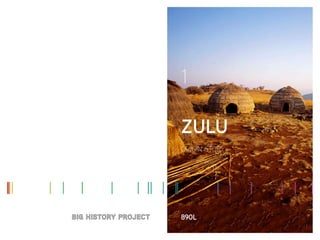
Unit 1: Origin Story: Zulu
- 2. UNKULUNKULU: THE GREAT ONE ZULU Compiled by David Baker, adapted by Newsela
- 3. 2 3 Different versions of the Zulu origin story all share this theme: Life has a single common ancestor.
- 4. 4 5 The Zulu are a proud African people, famous throughout history for their fierce- ness and bravery in fending off invaders. Archaeologists tell us they traveled to the lush green lands of south-eastern Africa many centuries ago from the huge lake regions to the north. Their creation story has many versions, passed down by word of mouth from generation to generation. It tells of how the ancestors of all plants, animals, and humanity began from a single source. At first, there was nothing but darkness. Earth was a lifeless rock. But in that darkness dwelt a god, Umvelinqangi, whose voice was like thunder and who, when angered, would shake the world with earth- quakes. Umvelinqangi created a single tiny seed. He sent it to the Earth. This seed was the very first life, from which all other life de- scended. It landed in the soil and sprouted into a long reed. The reed dropped more seeds, which fell off and grew into even more reeds. This continued until they covered a massive swamp to the north, the land called Uthlanga. At the end of one reed, there grew a man. His name was Unkulunkulu, known as “the first ancestor” and “the Great One.” Very small at first, he grew so large and heavy that he snapped off the end of the reed. Walking across the land of Uthlanga, he noticed men and women were sprouting at the ends of the other reeds. He picked them from the reeds. These people were the first humans, the ancestors of all nations, and they spread across the Earth. It was from Uthlanga that the ancestors of the Zulu journeyed south to the fertile lands they inhabit today. The Great One continued to walk among the reeds. He saw many forms of life growing at the end of them. He gathered the fish and flung them into the rivers. Fields and forests began to grow, so he harvested birds and antelope, and they darted off into the wild. He picked cattle so they could be used by humans. He plucked off a ball of fire and a round glowing stone, and flung them into the sky. These were the Sun and Moon. Light came into the world. The Great One also plucked from the reeds fierce lions and other beasts that would travel the lands hunting prey. He harvested magical creatures, some good and some bad. One was the snake-like goddess of the rivers, Mamlambo, rumored by some Zulu to drown people, eat their faces, and suck out their brains. Another goddess was Mbaba Mwana Waresa, a beautiful woman who created rain and rainbows, and who invented farming and gave the Zulu the gift of beer. One of the final acts of the Great One was the most tragic. He plucked the first chameleon off a reed and sent it to give humans the following message: “Men must not die.” By the words of the Great One, humans would become immortal. Unfortunately, the chameleon was slow and lazy in his journey. The Great One grew impatient and picked a different lizard from a reed. This lizard was fast and quickly arrived to give word to the humans. But the lizard did not bear the same instructions. Instead the lizard uttered the words, “Men must die.” And so from that day, humans became mortal. It is said that chameleons change color because they are so ashamed their ancestor was not fast enough to spare human- kind the invention of death. The Great One was so powerful in all he created, many Zulu suspect he was the god who sent the seed to Earth in the first place and that he used it to transform himself into flesh and blood. But Zulu histories have differing versions of the story. The one thing of which the Zulu are certain is that all life — including humanity — has a single common ancestor.
- 5. 76 Articles leveled by Newsela have been adjusted along several dimensions of text complexity including sentence structure, vocabulary and organization. The number followed by L indicates the Lexile measure of the article. For more information on Lexile measures and how they correspond to grade levels: http://www.lexile.com/about-lexile/lexile-overview/ To learn more about Newsela, visit www.newsela.com/about. The Lexile® Framework for Reading The Lexile® Framework for Reading evaluates reading ability and text complexity on the same developmental scale. Unlike other measurement systems, the Lexile Framework determines reading ability based on actual assessments, rather than generalized age or grade levels. Recognized as the standard for matching readers with texts, tens of millions of students worldwide receive a Lexile measure that helps them find targeted readings from the more than 100 million articles, books and websites that have been measured. Lexile measures connect learners of all ages with resources at the right level of challenge and monitors their progress toward state and national proficiency standards. More information about the Lexile® Framework can be found at www.Lexile.com. Sources Leeming, David Adams. Creation Myths of the World: An Encyclopedia. 2nd ed. Santa Barbara: ABC-CLIO, 2010. Lynch, Patricia Ann, and Jeremy Roberts. African Mythology: A to Z. 2nd ed. New York: Chelsea House, 2010. Image credits Zulu Huts on Film Set KwaZulu Natal, South Africa © Corbis
